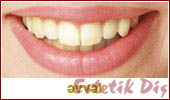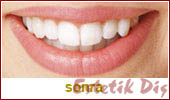|

In a modern society people pay great attention to the appearance of the teeth and even a little change in the appearance of the teeth can cause psychological anxieties. Change in color, form and position can be easily restored in dentistry. Bleaching of the teeth which have changed their color is cheaper, practical and harmless than the other restoration methods.
What is bleaching and how it is carried out?
Bleaching is an operation aimed to liquidate spots formed on the structure of teeth (on enamel and dentin layer). There are 2 possible bleaching methods. First of all is a method which can be applied by the patient himself and has the following stages:
- The doctor takes measure of the mouth, prepares slim rubber mould which you can put on your tooth.
- Patient puts medicine into the mould prepared specially for him and puts this mould on the teeth which are to be bleached for at least 6-8 hours (it is recommended during sleep),
- The treatment to be completed in 1-4 weeks.
The second method is bleaching carried out by the doctor in the clinic and it is applied in the following way:
- The bleaching medicine is placed on the tooth by the doctor who has experience on it.
- White light ray is directed on the tooth which is aimed to be bleached.
- After the operation the result is immediately observed.
Although both methods are effective, choice depends on the level of color, the wish of to complete the treatment shortly and doctor’s opinion.
 
What is the reason of spots formed on the tooth?
It can have a number of reasons. The reasons, which is met most of all are: old age, usage of substances coloring teeth (coffee, tea, cigarette etc.), injuries, old prosthesis and fillings. Often usage of antibiotics (tetracycline) or overuse of fluorine can also cause coloring of teeth. This situation can be caused by the structure of the teeth, as well as by the old age, mechanical injury and acceptance of antibiotics at the period of tooth growing.
To whom bleaching operation can be applied?
Almost everybody can afford it. But there are cases when the treatment can not be effective. After examining your oral cavity and making a diagnosis your dentist will find out if this operation suits you. If your teeth are healthy, this operation id ideal for white and natural smiling.
Is the bleaching operation difficult and painstaking?
No, it is not! Due to the development of oral cavity hygiene technology, our teeth can be bleached quickly and effectively.
Is it reliable?
Yes, it is! The researches made show that the bleaching operation under your doctor’s control is quite effective and reliable. Teeth and gingiva are not harmed.
How long is the implementation period?
Generally, bleaching starts since the first day of its implementation. For ideal appearance it must be applied for 10-14 days.
Can after bleaching teeth return to its earlier state?
After bleaching the teeth will always be whiter than they used to be. But 1 or 2 times in a year a maintaining treatment can be needed depending on the patient’s habits and state of his oral cavity.
What factors are important for successful operation?
- Brand of the medicine used and its composition.
- Experienced doctor.
- Form and period of usage of the medicine.
What have I to do during treatment?
1. If you are a smoker, you must not smoke while you have a rubber mould in your mouth.
2. After the completion of the treatment there will be a slight sensitivity to hot and cold.
The methods of teeth bleaching:
Bleaching methods are divided in 3 groups:
1) Chemical way of Teeth Bleaching
2) Photo- thermal way of Teeth Bleaching
3) Photo-chemical way of Teeth Bleaching
Chemical way of Teeth Bleaching
In this method bleaching gel is applied to the teeth with the help of the prepared teeth moulds. But it must be kept in mind that chemical bleaching can have a little harm on the enamel of the teeth. So these esthetic products must be applied under the doctor’s control.
Photo- thermal way of Teeth Bleaching
In this method also some quantity of gel is used. But its difference from the previous method is that it is applied with the help of special high-energy bunch of rays. Light ray source can consist of continuous LED or diode-laser. As there also can be harmful effect, this method also must be used under doctor’s control.
Photo-chemical way of Teeth Bleaching
In this method of bleaching, bleaching gel is activated with the usage of UV-lamp (blue light) or KTP laser (green light). This method is differentiated from the other ones by the fact that the source of light used in the method has a bleaching effect (photo oxidation). This provides more effective bleaching. While using UV-light, surrounding tissues (lips, gingival, tongue, etc) must be protected against possible burning. While using KTP laser, there is no burning risk, but gingiva must be protected from percolation of bleaching gel (gingiva block). One of the privileges of the KTP laser is lack of side effects. The toothpastes with fluorine used after the operation strengths the enamel of the teeth and protects from decays.
What is laser and how it is managed?
Lasers are devices giving one-color, straight, dense, one-space monochromic light. It can also be without color. Its visibility depends on the length of the wave. The length and strength of the wave determines usage space in medicine.

With the help of laser electromagnet waves becomes strong and speedy. So a high-energy light ray which has cutting and burning character is achieved in the site which is to be treated. The use of lasers varies depending on the length of wave.
In different wave lengths all tissues have different absorbing degree. For example, KTP laser has a wave with length of 532nm. KTP laser ray is very suitable for small and sensitive surgical operations, as it is easily absorbed by hemoglobin and oxyhemoglobin.
Work principle of laser:
Illuminating from outside can reach energy atoms achieved with the speed of electric current or in a chemical way. Some of them absorb this energy. Immense energy makes the atoms chaotic. A chaotic atom hit by photon and warned, spreads the most of the energy as a photon. Photons provide spread of other photons in the same way. Almost all the photons form a strengthening bunch of rays when it spreads. It is called a laser ray. As the laser rays are of high frequency, it has the characteristics of a sun ray. But the laser rays have one frequency.
How long the bleached teeth remain their whiteness?
The teeth bleached in different ways remain white for some years. But this period varies depending on the person. Nutrition and brushing habits, as well as smoking influence on the length of this period. It must be kept in the mind that bleaching not always provide with the range of whiteness you wish. Whitening degree depends on the initial ton of the teeth and varies from person to a person. Because of this you are recommended to discuss the result of the operation with your doctor in advance. Although teeth bleaching is an operation implemented frequently in dentistry, it is the field of esthetic dentistry. Most of people consider the smile with white teeth very attractive. Generally, milk teeth are whiter than the permanent teeth. When a man grows older, the color of his teeth gets darker. This darkness is the result of deformation in the mineral structure of the teth enamel .The teeth can also become darker because of bacteria pigments or smoking. As the white teeth gives younger look, all the people who are eager to have an esthetic appearance, wish to have it. But we also take info consideration that exaggerated whiteness can not be esthetic. The natural tone matching facial and mouth structure is more esthetic.
|